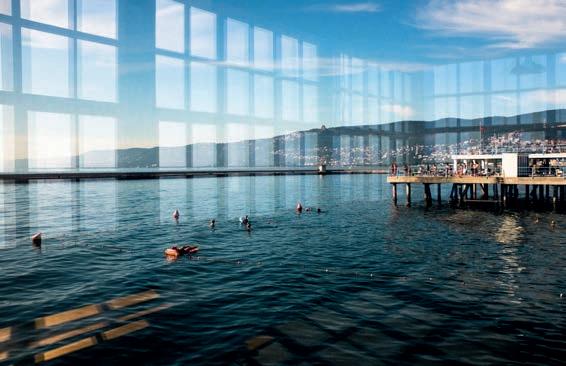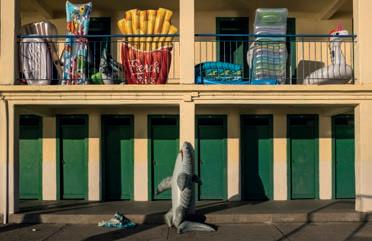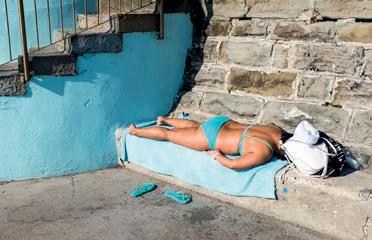
5 minute read
Al bagno
Città da scoprire
di /by
Advertisement
Giovanni Marzini
No, non è come pensate voi. Qui a Trieste quando diciamo di “andare al bagno” intendiamo un’altra cosa e questo è quello che vi raccontano queste pagine, attraverso un progetto fotografico che l’autore ha chiamato “L’inevitabilità del mare”. Già, perché in questa città il mare è decisamente “inevitabile”: non solo lo vedi e lo respiri, ma ti entra dentro, da subito, dai primi giorni della tua vita, per non lasciarti mai; almeno sino a quando avrai la forza di bagnartici dentro o solo vederlo, anche da lontano. Pensate che, una volta almeno, un po’ tutti a Trieste avevano la mania di contare quante volte erano andati… al bagno: nel senso di ricordare quante volte avevano nuotato nel mare di casa, da Muggia a Sistiana. I ragazzini soprattutto facevano a gara per finire l’estate presentando i loro record: sotto i 60 “bagni di mare” eri poca cosa, dai 90 in su incutevi rispetto. Anche se poi trovavi il pensionato che ti confessava di aver “timbrato” oltre un centinaio di giornate di mare in una stagione! “Inevitabilità del mare”, per i triestini di tutte le età che vedete in questi scatti ma –e ce lo auguriamo– anche per i “triestini temporanei” che leggeranno queste pagine!
ENGLISH TEXT
No, it is not what you think. Here in Trieste when we say andare al bagno (the word bagno means both bathroom and bathing establishment) we mean something else and this is what these pages tell you, through a photographic project that the author has called ‘The inevitability of the sea’. Yes, because in this city the sea is definitely ‘inevitable’: not only do you see it and breathe it, but it also gets inside you, from the very first days of your life, never to leave you; at least until you have the strength to bathe in it or just see it, even from afar. Just think that, once upon a time at least, everyone in Trieste was obsessed with counting how many times they had gone... swimming: in the sense of remembering how many times they had swum in the sea at home, from Muggia to Sistiana. The kids in particular competed to finish the summer by presenting their records: under 60 ‘sea baths’ you were little thing, from 90 upwards you commanded respect. Even if you then found the pensioner with a Caribbean tan who confessed to having ‘stamped’ more than a hundred sea days in a season! “Inevitability of the sea’, for the Triestines of all ages you see in these shots but –and we hope– also for the ‘temporary Triestines’ who will read these pages! In questa città il mare è decisamente ‘inevitabile’: non solo lo vedi e lo respiri, ma ti entra dentro, da subito, dai primi giorni della tua vita, per non lasciarti mai. — In this city the sea is definitely ‘inevitable’: not only do you see it and breathe it, but it also gets inside you, from the very first days of your life, never to leave you.


L’inevitabilità del mare
Città d’angolo, di confine, vecchia e spesso dimenticata, Trieste ha nel suo lungomare il luogo dove forse è più facile riconoscere la sua anima. Gli storici stabilimenti balneari e le acque placide dell’Adriatico fanno da cornice ad uno spazio familiare e quotidiano, tanto che in dialetto i triestini dicono di “andare al bagno” anziché “andare al mare”, evocando così il rapporto di profonda intimità e di quotidianità che li lega al paesaggio marino. Uno spazio dunque dove raccogliersi con i propri pensieri in un tempo che si fa sospeso, tra un presente rivolto al passato e un futuro di continuo rimandato. A Trieste non c’è via di fuga dal mare e gli abitanti si abbandonano a questa inevitabile circostanza. [TV]
The inevitability of the sea
Old and often forgotten, the Italian border town of Trieste has in the waterfront its largest characterization: the old beach resorts and the placid waters of the Adriatic sea serve as a frame for a familiar and everyday location where the triestinos use the expression “andiamo al bagno” that literally can be translated as “let’s go to the bathroom” instead of the italian “andiamo al mare”, summoning the profound initmate relationship, and the need to be conncected to, with the sea. The ideal place to gather oneself in one’s own thoughts where time simply stands still. A present steeped in the past and a future continuously postponed. In Trieste, there is no escape from the sea and the city dwelllers let themselves go with this inevitable circumstance. [TV] “Gli storici stabilimenti balneari e le acque placide dell’Adriatico fanno da cornice ad uno spazio familiare e quotidiano.” — “The old beach resorts and the placid waters of the Adriatic sea serve as a frame for a familiar and everyday location.”


Nato a Genova nel 1977 si laurea in Scienze Politiche all'Università di Padova. Si avvicina alla fotografia da ventenne come fotografo di strada. Dal 2015 al 2016 frequenta una masterclass in reportage fotografico a Roma che gli ha permesso di spostare la sua attenzione dalle singole foto ai progetti a lungo termine e di sviluppare un personale linguaggio visivo basato sulla commistione di più generi. Innamorato dei luoghi autentici che rimangono immutati nel tempo, la fotografia è per lui un atto di pura libertà e fantasia e l'umanità che incontra uno specchio su cui riflettersi. Negli ultimi anni è stato premiato in concorsi internazionali (Street Photo Milano, Brussels Street Photography Festival) e ha pubblicato su riviste italiane e straniere (Erodoto, Les Echos Magazine, Internazionale). Attualmente vive a Trieste, sua città adottiva. –Born in Genova (Italy) in 1977 he graduated in political science at the University of Padova. He approaches photography in the early 20s as a street photographer. From 2015 to 2016 he attended a masterclass in photo reportage in Rome which enabled him to shift his focus from single photos to long term projects and to develop a personal visual language based on the mixture of multiple genres. In love with authentic places which remain unchanged, photography to him is an act of pure freedom and imagination and the humanity he met a mirror where he can reflect himself. Over the past few years he was awarded in international contests (Street Photo Milan, Brussels Street Photography Festival) and published with print media (Erodoto, Les Echos Magazine, Internazionale). He currently lives in Trieste, his adoptive city.










